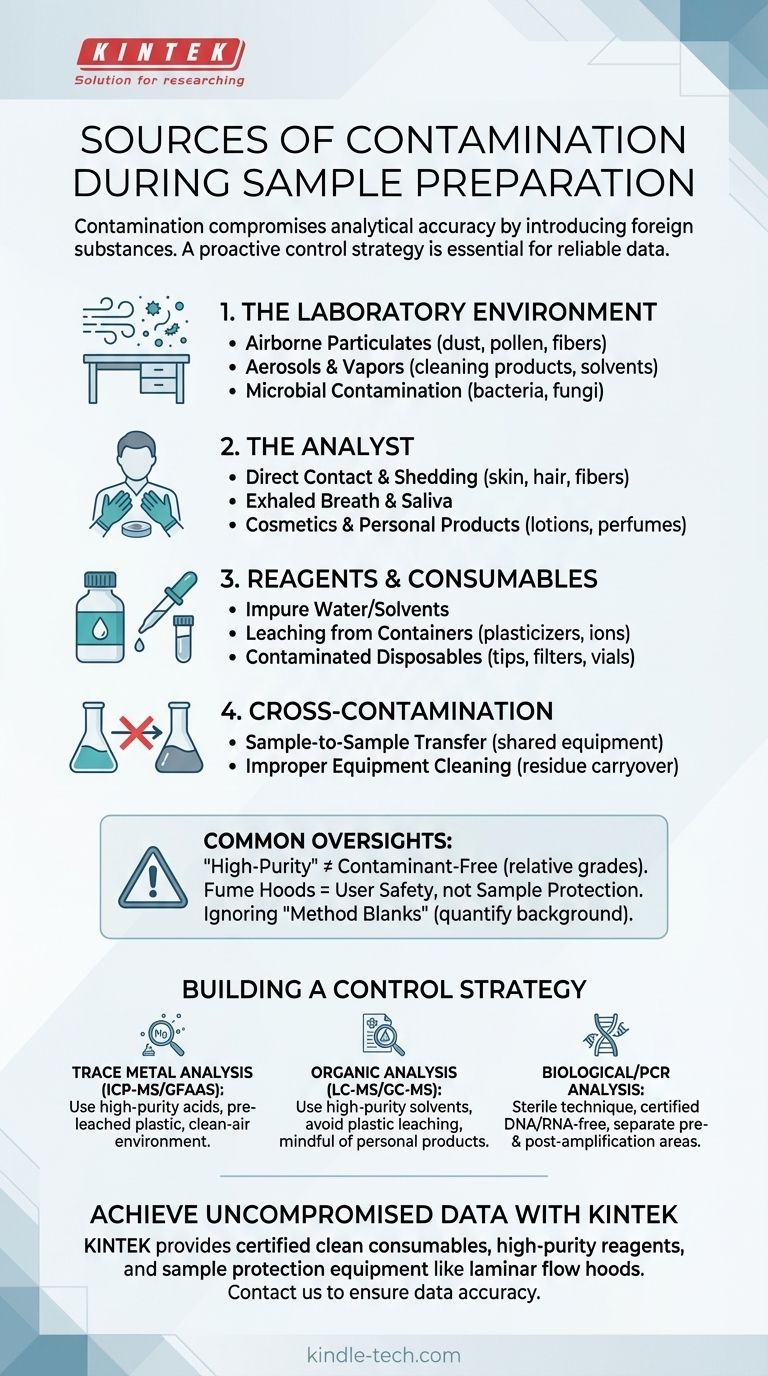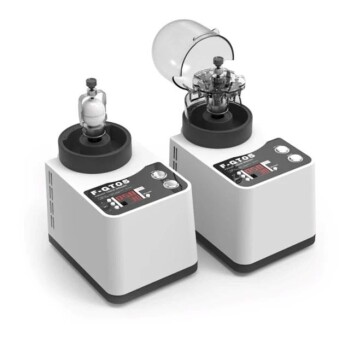At its core, contamination during sample preparation originates from four primary sources: the laboratory environment, the analyst performing the work, the reagents and equipment used, and cross-contamination from other samples. Each source introduces foreign substances that can invalidate analytical results by obscuring, mimicking, or artificially inflating the signal of the target analyte.
The central challenge is not merely knowing these sources, but recognizing that contamination is a constant, pervasive risk. Achieving accurate and reliable data depends on a systematic and proactive control strategy that addresses every step of your workflow, from the air you breathe to the vials you use.

The Laboratory Environment: The Invisible Threat
The ambient air and surfaces in any laboratory are filled with potential contaminants. Even in a seemingly clean space, these sources can compromise sensitive analyses.
Airborne Particulates
Dust, fibers from building materials, and pollen are ubiquitous. These particles can carry a wide range of elements, particularly silicon, aluminum, calcium, and iron, which can interfere with trace element analysis.
Aerosols and Vapors
Aerosols from cleaning products, air fresheners, or nearby chemical processes can settle into an open sample. Volatile organic compounds (VOCs) from solvents, plastics, and paints in the room can also be absorbed.
Microbial Contamination
Airborne bacteria and fungi are always present. For biological analyses like PCR or cell culture, this is a direct source of failure, introducing foreign DNA, RNA, or competing organisms that ruin the experiment.
The Analyst: The Human Factor
The person preparing the sample is often the most significant and dynamic source of contamination. Without conscious effort and proper technique, introducing contaminants is almost unavoidable.
Direct Contact and Shedding
Skin cells, hair, and fibers from clothing are constantly shed. These can introduce organic compounds, salts, and in the case of biological work, foreign DNA and enzymes like DNases that degrade samples.
Exhaled Breath and Saliva
Simply breathing or talking over a sample can introduce moisture, microorganisms, and various organic compounds. This is a critical risk for ultra-trace analysis.
Cosmetics and Personal Products
Hand lotions, soaps, perfumes, and other cosmetics contain complex mixtures of organic compounds, oils, and inorganic materials (like titanium dioxide). These can easily be transferred to samples and equipment, creating significant interference.
Reagents and Consumables: The Tools of the Trade
The materials you use to prepare, hold, and transfer your sample are direct pathways for contamination. Their purity must be appropriate for the sensitivity of your analysis.
Purity of Reagents and Water
The water and solvents used for dilutions and extractions are a major source. Even "high-purity" grades can contain trace levels of contaminants that are significant for highly sensitive methods like ICP-MS or LC-MS/MS. Using the wrong grade is a common error.
Leaching from Containers
Plastic and glass containers can leach substances into your sample. Plasticizers (like phthalates), stabilizers, and mold-release agents can leach from plasticware. Ions like sodium, boron, and silicon can leach from certain types of glass, especially under acidic or basic conditions.
Contaminated Disposables
Single-use items like pipette tips, vials, and filters are not inherently sterile or contaminant-free unless specifically certified. They can be a source of metals, organic compounds, and biological material from the manufacturing and packaging process.
Cross-Contamination: The Internal Saboteur
Cross-contamination occurs when residue from one sample is inadvertently transferred to another. This is particularly dangerous when working with samples of vastly different concentrations.
Sample-to-Sample Transfer
Carryover can happen if the same pipette tip, glassware, or syringe is used for multiple samples without meticulous cleaning. A high-concentration standard or sample can leave behind enough residue to significantly alter the results of a subsequent low-concentration sample.
Improper Equipment Cleaning
Insufficiently cleaned glassware, spatulas, or homogenizers are a primary cause of cross-contamination. The cleaning protocol must be validated to ensure it effectively removes all traces of the previous sample and any cleaning agents used.
Common Oversights and False Assumptions
Building trust in your data requires moving beyond the obvious and addressing the subtle, often-overlooked sources of error.
"High-Purity" Doesn't Mean Contaminant-Free
The term "high-purity" is relative. For example, "HPLC-grade" solvent is tested for UV-absorbing impurities but may contain trace metals that would interfere with an ICP-MS analysis. Always match the reagent grade to the specific requirements of your instrument and target analytes.
The Fallacy of the Fume Hood
A standard chemical fume hood is designed for user safety, not sample protection. It works by pulling large volumes of unfiltered laboratory air into the hood and over your sample before exhausting it. For sensitive work, you need a laminar flow hood or clean bench, which provides a curtain of HEPA-filtered air to protect the sample from the environment.
Ignoring the "Blank"
Failing to prepare and analyze a "method blank" is a critical error. A blank is a "mock" sample containing all reagents and subjected to every preparation step, but with no actual sample matrix. It quantifies the background contamination from your entire process, allowing you to distinguish a true signal from noise.
Building a Contamination Control Strategy
Your approach should be tailored to the specific demands of your analysis. The most sensitive methods require the most stringent controls.
- If your primary focus is trace metal analysis (ICP-MS/GFAAS): Prioritize using high-purity acids, pre-leached plasticware (not glass), and working in a clean-air environment to minimize airborne dust.
- If your primary focus is organic analysis (LC-MS/GC-MS): Prioritize using high-purity solvents, avoiding plastic consumables that can leach plasticizers, and being mindful of contamination from personal products.
- If your primary focus is biological/PCR analysis: Prioritize sterile technique, using certified DNA/RNA-free consumables, and physically separating pre- and post-amplification areas to prevent cross-contamination.
Ultimately, vigilance and a systematic approach are the foundation of reliable and defensible analytical data.
Summary Table:
| Source of Contamination | Key Risks & Examples |
|---|---|
| Laboratory Environment | Airborne particulates (dust, fibers), aerosols, vapors, microbial contamination. |
| The Analyst | Shed skin/hair, exhaled breath, cosmetics, and personal care products. |
| Reagents & Consumables | Impure water/solvents, leaching from containers (plasticizers, ions), contaminated disposables. |
| Cross-Contamination | Sample-to-sample transfer via shared equipment, improper cleaning of glassware and tools. |
Achieve Uncompromised Data Integrity with KINTEK
Are contamination concerns compromising your analytical results and impacting your research or quality control? KINTEK specializes in providing the high-purity lab equipment and consumables you need to build a robust contamination control strategy.
We supply:
- Certified Clean Consumables: Low-background tubes, vials, and filters to minimize leaching.
- High-Purity Reagents: Acids and solvents graded for specific techniques like ICP-MS and LC-MS.
- Sample Protection Equipment: Laminar flow hoods and clean benches to shield your samples from the lab environment.
Let our experts help you identify the right tools for your specific application—whether it's trace metal analysis, organic compound detection, or sensitive biological work.
Contact KINTEK today to discuss your sample preparation challenges and ensure the accuracy of your data.
Visual Guide

Related Products
- Custom Machined and Molded PTFE Teflon Parts Manufacturer for Laboratory ITO FTO Conductive Glass Cleaning Flower Basket
- Laboratory High Throughput Tissue Grinding Mill Grinder
- Laboratory Hybrid Tissue Grinding Mill
- Lab Vibration Mill
- Laboratory Grinding Mill Mortar Grinder for Sample Preparation
People Also Ask
- How should a PTFE cleaning basket be stored when not in use? Maximize Lifespan & Prevent Contamination
- How should an appropriate PTFE cleaning basket be selected? A Guide to Efficient and Safe Lab Cleaning
- What are the common specifications and shapes for PTFE cleaning baskets? Maximize Chemical Purity & Process Integrity
- What maintenance procedures are recommended for a PTFE cleaning basket? Extend Equipment Life & Ensure Process Purity
- What is the correct way to place items into a PTFE cleaning basket? Master the Art of Perfect, Repeatable Cleaning











